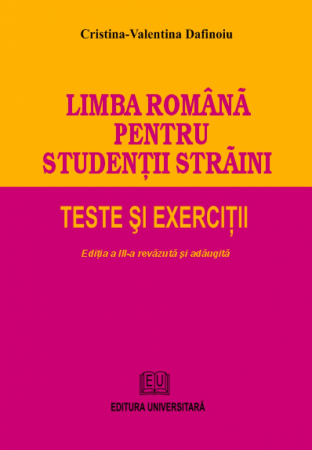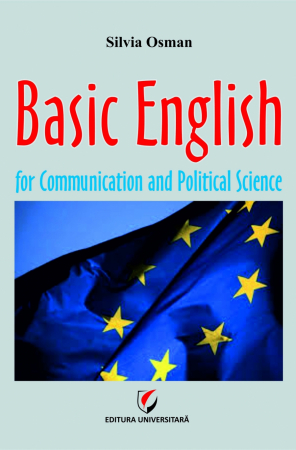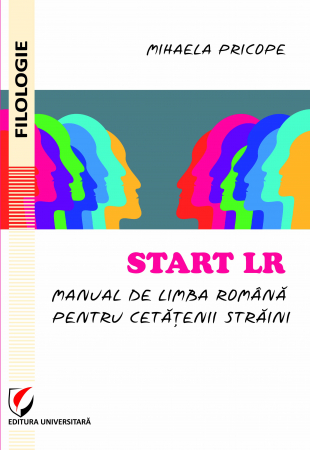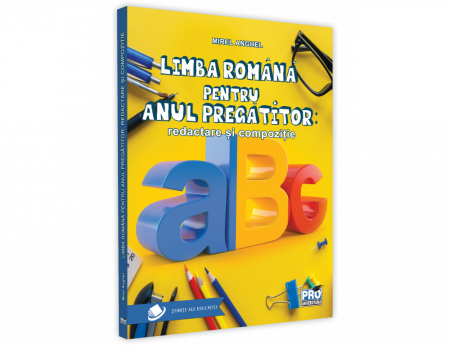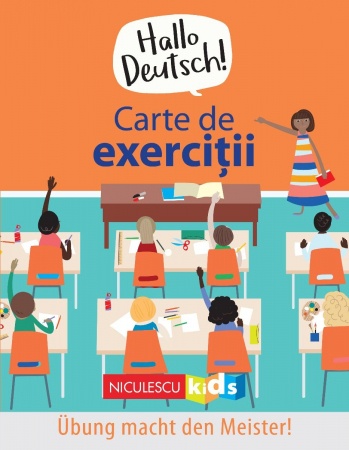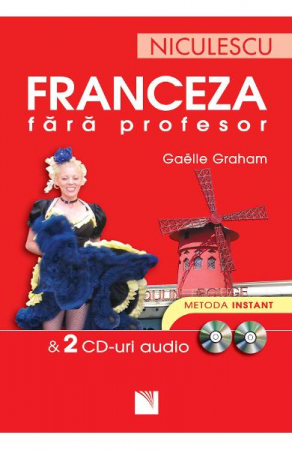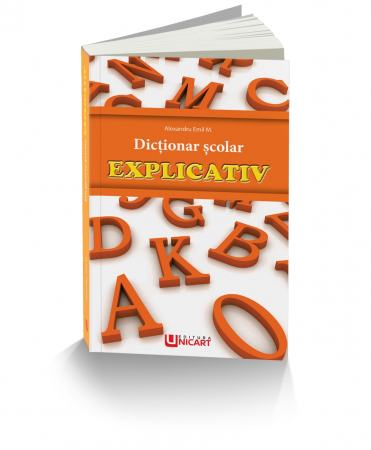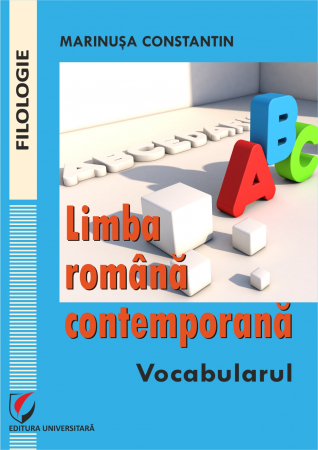ISBN: 978-606-28-0273-8
DOI: 10.5682/9786062802738
Publisher year: 2015
Edition: III, revizuita
Pages: 204
Publisher: Editura Universitara
Author: Cristina Valentina Dafinoiu, Laura Elena Pascale
- Description
- Download (1)
- Authors
- Content
- More details
- Where to find it
- Reviews (0)
The interest for the Romanian language as a foreign language is growing lately. The reasons are diverse, from the interest for Romance or comparative linguistics, to the one to study in Romania or Moldova, or to follow various specializations, facilitated by various funding programs, from Fulbright and Eurasian Regional Language Program, to masters and doctorates with national or local support.
As a result, more and more sophisticated textbooks for learning Romanian as a foreign language have been developed in recent decades and this course is the latest teaching tool given to the field, but also one of the most inspired. Although it is addressed primarily to students in the preparatory year at the "Ovidius" University of Constanta, it could be used successfully in any lectureship in the world, as it does not use any language of mediation, but only offers Romanian through .. Romanian, being strongly supported by images.
It is an exemplary manual, extremely well structured, very user-friendly and extremely efficient, despite the lack of attractive colors or audio-video materials. The lessons are perfectly adapted to the learning needs specific to the A1-A2 level, and the exercises are varied and efficient. The recapitulative units conclude each cycle of five lessons, ensuring the definitive fixation of the acquired knowledge and the retouching of the eventual imprecise assimilations. The appendices contain very well structured grammar notions, which students can use when they have some hesitations in solving the proposed exercises.
The two authors, graduates of the Faculty of Letters at the "Ovidius" University of Constanta, although still very young, have a long experience in the field, teaching Romanian as a foreign language for many years in the preparatory year at the same university. Previous volumes of tests and the multitude of teaching materials adjacent to the teaching process they have developed over time fully demonstrate their concern for finding the most effective teaching methods and explain the remarkable results they have achieved over the years, giving the chances to the multiple generations of foreign students to acquire the Romanian language and to follow different specializations within the “Ovidius” University, but also in other famous universities from all over the country.
Members of the Center for Research and Professional Development "Romanian Studies in International Context" (STUR) at "Ovidius" University, the two authors are actively involved in all actions to promote Romanian studies and work hard to achieve a learning platform on -line, to be made by the staff of this center. This book is a firm step towards the development of this platform.
I have no doubt that this course will have multiple successive editions and will become a reference teaching tool in the field of Romanian studies.
Conf.dr. Marina Cap-Bun
Director STUR
-
LIMBA ROMÂNĂ. MANUAL PENTRU STUDENȚII STRĂINI DIN ANUL PREGĂTITOR (Nivel A1-A2)
Download
LAURA ELENA PASCALE
Unit # 1
The alphabet / 11
• Graphic representation of letters in the Romanian alphabet / 11
• Groups of letters / 14
• Phonetic transformations / 17
Unit # 2
Who is she? / 19
• Personal pronouns in the nominative / 21
• The verb to be in the present (affirmative / negative) / 22
• Place and time (where / from where; when / from when) / 22
• Noun (fem. -A / -e; masc. -Ø / -i) / 22
• Interrogations. Who? What the? How many? How many? / 22
• Numbers from 0 to 19/23
Unit # 3
In a classroom / 27
• The verb to have in the present (affirmative / negative) / 28
• Noun (genres and numbers) / 28
• In a / -o; from a / -o / 29
• Many / few / few / each / 29
• Nobody / nothing / 29
Unit # 4
What's the weather like? / 33
• Cardinal points / 34
• Notions of time (moments of the day, days of the week, months of the year, seasons, date) / 34
• From when / until / 36
• Numbers from 20/36
Unit # 5
In Constanta / 41
• Notions of space (from where / to where) / 42
• The decided article / the undecided article / 42
• All / all / 44
• The adjective with four forms / 44
• Very + adjective / 45
• The verbs to do and to go to the present (affirmative / negative) / 45
Unit # 6 - Recapitulation / 51
Unit # 7
In classes / 59
• Notions of time: time expression / 60
• The verb in the infinitive; classification of verbs / 61
• The present indicative verb / 62
• Verb + preposition + noun / 63
Unit # 8
After courses / 69
• Verbs in the present indicative ending in: -ez, -esc, -asc / 70
• The verb in the imperative, second person plural / 71
• Pronouns and the demonstrative adjective of closeness: this, this, these, these / 71
• Much, -a / little, -a / everything, all + singular noun / 72
Unit # 9
The supermarket / 79
• How much does it cost? / 83
• Colors / 83
• Variable adjectives with 2 and 3 forms / Invariable adjectives / 84
• The past: the perfect compound / 85
• The participle with adjective value / 85
Unit # 10
The students rented a house / 93
• The verbs to cut, to divide, to delay in the present / 95
• Mai + adjective / adverb / verb / 95
• The genitive (proper nouns, common nouns) / 95
• Prepositions with the genitive / 97
• Indefinite pronoun / adjective un (ul) / alt (ul) / 98
Unit # 11
The restaurant / 105
• The verbs to take, to stay, to give in different communication situations / 109
• Verbs to eat, to place in the present / 109
• The present subjunctive: the formation of the subjunctive, the distribution of the subjunctive, the subjunctive of some irregular verbs, the subjunctive with imperative value / 109
• Personal pronouns in the accusative - accentuated forms / 111
Unit # 12 - Recapitulation / 119
Unit # 13
The hospital / 127
• Personal pronouns in the accusative - unaccented forms / 129
• The position of unaccented pronominal forms in relation to the verb / 130
• Replacing the noun direct object with personal pronoun / 131
• Personal pronouns in the accusative - accentuated forms + unaccented forms / 131
• Interrogative pronoun in accusative (direct object) / 132
Unit # 14
The travel agency / 139
• Means of transport / 141
• The future (I will ... / you ... / I will ...) / 142
• The future accompanied by personal pronouns in the accusative / 143
• The adjective / pronoun demonstrative of distance that / that / 143
• The imperative, pers. a II-a singular / 144
Unit # 15
On a trip to Bran / 151
• Verbs ending in -a with alternating oa / u / 153
• The reflexive pronoun in the accusative / 153
• Verbs with reflexive pronouns in the accusative / 153
• The position of the reflexive pronoun in relation to the verb / 154
• The verb to be able and the reflexive pronoun / 155
Unit # 16
My family / 161
• Realization of possession in Romanian / 162
• The genitive. Structure: noun + adjective, noun + possessive adjective, noun + qualifying adjective, noun + demonstrative adjective / 163
• The degrees of comparison of the adjective / adverb / 164
Unit # 17
Shopping / 171
• Personal pronouns (accented forms and unaccented forms) in dative / 173
• The position of pronouns in the dative in relation to the verb / 174
• Verbal constructions with the dative / 175
• Nouns in the dative case / 175
• Both / both / 176
Unit # 18 - Recapitulation / 183
Annexes - Grammar notions for Level A1-A2 / 197
The work Romanian Language. Handbook for foreign students in the preparatory year. Level A1-A2, now in its third edition, is addressed, as mentioned in the title, primarily to foreign students in the preparatory year, who come to Romania to attend Romanian universities in various specializations, in Romanian.
At the same time, we consider that the paper, made according to the descriptors of the Common European Framework of Reference for Languages (CEFR) is particularly useful for all foreigners who are interested in obtaining a minimum knowledge of the Romanian language.
Certainly, the experience gained during the years of activity with groups of foreign students has been very helpful in compiling and structuring learning units that include texts on topics from different fields, very useful for students in discovering the realities of Romanian society, complemented by a lexicon adapted to the needs of expression at beginner level, grammar problems explained for everyone's understanding and finally a set of very varied exercises, which approach all language compartments and which combine in an efficient and attractive way the vocabulary knowledge with the phonetics, morphology and Romanian syntax.
In order to remove the monotony of repeating the same type of exercise, we combined the exercises that allow the development of the student's reading skills, with exercises for developing writing skills (exercises involve replacing some forms with others, finding antonyms / synonyms, choosing a correct variant, answer to questions, finding mistakes and correcting them, filling in the blanks, composing on various topics, etc.) and speaking in Romanian (descriptions of images, conducting dialogues in different communication situations). All types of exercises approached in the textbook require from the students a good knowledge of the vocabulary and grammar of the Romanian language at beginner level, but also a special attention in finding the solutions.
The texts and exercises are doubled by the presentation of clear and suggestive images for the approached language problem, which makes the students to be won from an emotional point of view, which is very important in the process of teaching-learning Romanian as a foreign language. These images help a lot to Romanian language users in developing oral expression skills.
Therefore, the structure of the textbook was designed so as to obtain a unitary whole, and the communication skills (understanding a written text and an oral message, producing written text and producing an oral message), based on a solid linguistic competence, to be equally present in all learning units. Each unit was designed to cover approximately 10 (ten) course hours, this limit can be changed plus or minus, depending on the specific profile of each group of students.
The paper wants to be of an applicative type, with a content adapted to the needs of expression in Romanian at the A1-A2 level.
Without claiming to have found the formula of the perfect textbook for learning Romanian as a foreign language, we hope that this paper will be of real use to both teachers who are concerned with teaching Romanian to non-native speakers and students and to all foreigners who want to discover the Romanian language in all its aspects.
The Authors
Customer Support Monday - Friday, between 8.00 - 16.00
0745 200 718 0745 200 357 comenzi@editurauniversitara.ro
6359.png)
![Romanian Language. Manual for Foreign Students in Preparatory Year (Level A1-A2) [1] Romanian Language. Manual for Foreign Students in Preparatory Year (Level A1-A2) [1]](https://gomagcdn.ro/domains/editurauniversitara.ro/files/product/large/limba-romn-manual-pentru-studenii-strini-din-anul-pregtitor-nivel-a1-a2-724-557767.jpg)



